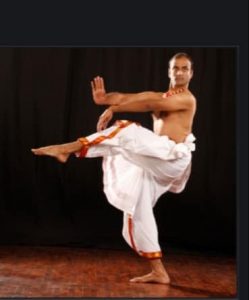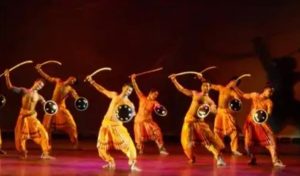By: Rusiraj Pattanayak
~ History of World Famous Mayurbhanj Chhau ~
The Mayurbhanj Chhau dance is primarily maskless and renowned for its ‘Taandava’ (vigorous) and ‘Laasya’ (soft) dance substance. This Chhau dance is essentially a ritual based dance of Siva Gajan or Chaitra Parav. This unique folk-dance form is transmitted from generation to generation through precise training, regular practice and endurance of oral tradition.
In Odisha, the evolution and growth of the Chhau dance of #Mayurbhanj has gone through a lot of ups and downs. The different kings of Bhanja dynasty were great patrons of art and culture. The Chhau dance was flourished into a better form under the sponsorship of the #Bhanja rulers of Mayurbhanj state. Prior to the rule of #Maharaja#Jadunath Bhanja (1823-1863) the Chhau dance in Mayurbhanj was not popular as it is today. At the time of Maharaja Jadunath Bhanja, the Rama Leela dance was performed for the first time during the Rama Navami festival in the month of Chaitra. After few years later #Madan#Singh#Babu came to Baripada from Dhalbhum who added Chhau music in this Rama Leela dance. In this way the Mayurbhanj Chhau Dance started growing under the Royal Patronage.

The musical instruments of Chhau dance came into existence accordingly. Most probably in this way the #Rama #Leela dance was changed into the Chhau dance during that period. At that time the performers of Rama Leela dance were covering their faces with various types of masks related to the character. Although now-a-days the artists of Mayurbhanj Chhau dance are giving much more emphasis on the facial expression but initially the masks were used for various characters. The Mayurbhanj Chhau dance became very popular during the reign of Maharaja #Krushna #Chandra Bhanja #Deo (1868-1882). #Mr. #Ramahari #Bebarta Babu, a faithful aid of Maharaja witnessed the Chhau dance of #Saraikela and requested to Maharaja Krushna Chandra Bhanja for the development of Mayurbhanj Chhau dance accordingly. Then Maharaja Krushna Chandra Bhanja brought Mr. #Upendra #Biswal, a Chhau Ustad from Saraikela and appointed him to teach the Chhau dancers of Uttarsahi. After two or three years Mr. Banamali Das, another Chhau Ustad from Saraikela was appointed to train the Chhau dancers of Dakshinsahi. For that Maharaja gave them a rent free (Lakharaj) land grant.
These Lakharaj lands are still being enjoyed by the successors of these two Ustads and they claimed themselves as successors of the Adi-Gurus (first preceptors) of the Mayurbhanj Chhau dance. At that time Mr. Brundaban Chandra Bhanj Deo, the then Chhotrai Saheb and Mr. Gokul Chandra Bhanj Deo, the then Routrai Saheb were in-charge of Uttar-sahi and Dakshin-sahi Chhau dance parties respectively. In this way the Mayurbhanj Chhau dance was developed to some extent during the reign of Krushna Chandra Bhanja Deo. He laid the foundation on which his son Maharaja Sriram Chandra Bhanja Deo raised the Chhau edifice of the State. After the death of Maharaj Krushna Chandra Bhanja Deo in 1882 the Chhau dance was performed in the palace at the time of Chaitra Parva for two days only to keep the festival alive. Maharaja Sriram Chandra Bhanj Deo took over the charge of the administration of the State in 1892. The annual performance of Chhau dance was presented inside the Palace of the Maharaja of Mayurbhanj for three days prior to the Chaitra-Sankranti i.e. roughly from 11th April to 13th April. At that time these two prominent parties were competing with each other and the winning party was being awarded a running cup known as Talcher Cup. At that time Chhotrai Saheb Shyam Chandra Bhanja, the younger brother of Maharaja Sriram Chandra Bhanja Deo and Routrai Saheb Sreedam Chandra Bhanja took charge of the training and performance of the Uttar-sahi and Dakshin-sahi Chhau dances respectively, with an annual grant of Rs. 2,000/- for each sahi.
Apart from this amount, each brother was to spend as much as Rs.15,000/- every year for the training and development of the Chhau dance. Both of these brothers were not only personally participating in the actual dance performances but also supervising the daily food of the Chhau dancers. The training and practice of Chhau dance was going on all over the year and during that time many new artists were introduced.

At that time the Uphuli, Basipaiti, Dhana Pachuda, Jhuntiamaja, Govara Gala, Bidya Sundara, TamuliaKrishna, the Uttarsahi and Dakshinsahi Chhau dance parties practiced Hindustani, etc. In this way the Chhau dance was developed and occupied a unique place among the people of Mayurbhanj during the period of Maharaja Sriram Chandra Bhanja Deo. In 1912 the Maharaja took special attention for the development of Chhau dance. With the help of his brother Routrai, Maharaja introduced a new dance form, which was famous as ‘War Dance’. Maharaja had spent a lot of money for the creation of this special dance. The dance was for the first time performed at Calcutta to welcome the British Emperor George-V and Queen Mary in 1912. This ‘War Dance’ is shown to be essentially a sort of mock-fight between two opposite groups holding swords and spears in their hands. The dancers are dressed in red or blue dhotis, turbans along with feather-garlands round the arms and waists. They painted their faces and bodies with ochre or red colour. The beautiful presentation of the Chhau artists was very much appreciated by the Emperor George-V and Queen Mary. Maharaja Sriram Chandra Bhanja was died in 1912. The appreciation of Chhau dance by the Emperor George-V and Queen Mary was reflected in his condolence letter, which he had sent after the death of the Maharaja Sriram Chandra Bhanja Deo.
In this appreciation letter he wrote, “The Queen and I are grieved to hear of the death of Maharaja of Mayurbhanj. Please convey to Maharani our sincere condolences with her in her sorrow. We remember of course the important part taken by the Maharaja in connection with the pageant on the maidan and our pleasure in seeing him on that occasion”.
After the death of Maharaja Sriram Chandra the Chhau dance faced different type of problems. During that period, Maharaja Purna Chandra Bhanja Deo had given only an annual grant of Rs.250/- to each sahi for the purpose of keeping up the ceremony. Because of the financial scarcity due to the World War and the decreasing number of artists the practice duration got reduced. They practiced only one or two months in place of practicing the whole year. In view of this great dwindling, Maharaja Purna Chandra Bhanja gave special attention to revive the Chhau dance. However, such efforts could not yield great results.
Some internal conflicts with the dance teachers the dancers resulted in stoppage of the practice. Maharaja Purna Chandra Bhanja Deo had no offspring. He died in 1928. After his death his younger brother Pratapa Chandra Bhanja Deo became a Maharaja of Mayurbhanj. He was very much interested in the Chhau dance and gave special attention to develop the Chhau dance of Mayurbhanj. He increased the annual grant to Rs.5,000/- for each sahi. He formed a committee for each sahi and a manager was appointed to look in to the dance related activities. The committee took special attention for the training of the artists and their presentation at the time of the Chaitra Parva. Several new dance themes were composed and introduced in the Chhau dance. During this period a new era of Chhau dance was started.
Source: Sri B.K. Mohanata, Sri Durga Charan Mohanta and Asutosh Bhattacharya
Images: Kumaresh Nayak